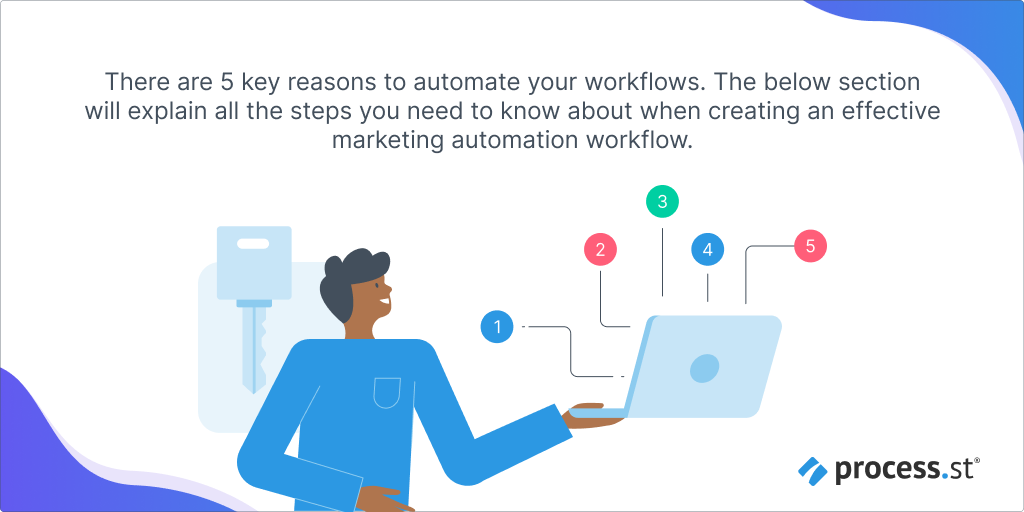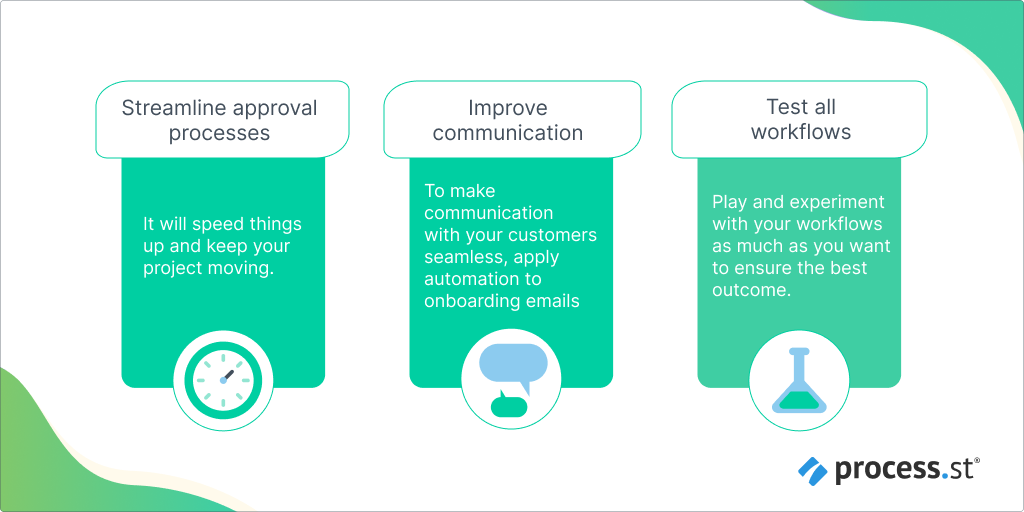Get started quickly, see results immediately, no code needed.
Master Marketing Automation Workflow: An Easy Step-by-Step Guide
Do manual processes keep causing you problems? Are they making your business slower and less efficient? You need a marketing automation workflow!
Every department in your company can benefit from a marketing automation workflow.
But what is a marketing automation workflow?
Marketing automation workflows are designed to help you complete tasks without manual input.
Make your life easier and your work more consistent and much faster.
This page will highlight all the benefits of automating your workflows and give you a step-by-step guide on how to do it.
We’ll also look at some commonly found challenges relating to workflow automation and show you how to avoid them.
What is a marketing automation workflow?
Marketing automation workflow refers to the process of automating repetitive marketing tasks to streamline and optimize marketing processes.
It involves the use of marketing automation tools and technology to create a series of automated actions and triggers that guide potential customers through their customer journey.
Implementing marketing automation workflows is crucial for businesses as it helps to save time and resources by eliminating the need for manual tasks.
By automating processes such as email campaigns and follow-up emails, marketing teams can focus on creating relevant content and strategies to engage potential customers.
Best marketing workflows to automate
There are many different types of marketing automation workflows. Each of them falls into one of the following categories:
Lead-nurturing workflows
Lead nurturing workflows are designed to develop and maintain relationships with potential customers.
They automate messages that are highly personalized to each customer.
Some examples of lead nurturing workflows are:
Marketing automation workflow for lead generation
Help your staff attract potential customers by following specific tasks and checklists.
Marketing automation workflow for email marketing
These workflows will help you nurture your leads by sending customers specific and highly personalized emails.
Marketing automation workflow for social media marketing
Enables planning, creating, and sharing content on all social media channels.
Marketing automation workflow for content marketing
It’s designed to make your content team follow a structured plan and make their work more efficient.
Marketing automation workflow for account-based marketing
Build campaigns, create customer personas, and personalize your content.
Customer segmentation workflows
Customer segmentation workflows are designed to gather customer data, identify certain patterns, and separate customers into groups based on those patterns.
Some examples of customer segmentation workflows are:
Marketing automation workflow for customer segmentation
They help you gather customer information without manually entering data.
Marketing automation workflow for event marketing
Allows for budget planning and automates tedious processes to regain control over your meetings and events.
Marketing automation workflow for A/B testing
Helps you plan ahead and stay organized.
Marketing automation workflow for multichannel marketing
Lets your leads choose how they want to connect with you and via what channel.
Benefits of automating your marketing workflows
Workflow automations allow you to automate processes and tasks to overcome many issues.

- They save you money allowing employees to concentrate on revenue-generating tasks.
- They save you time redirecting your employees’ attention to more pressing issues.
- They minimize errors eliminating the need for manually performed tasks, such as data entry.
- They make approvals effortless because you can handle multiple ones simultaneously.
- They increase productivity because your team doesn’t have to perform repetitive tasks.
This section will explain all the steps you need to know about when creating an effective marketing automation workflow.
1. Analyze your requirements
The first step in creating an effective marketing automation workflow is to analyze your requirements. This involves understanding the key components of your marketing automation strategy, such as the types of campaigns you will be running and the objectives you want to achieve.
2. Set clear objectives
Once you have analyzed your business requirements, you can set clear objectives for your marketing automation workflow. This will help ensure your workflow is tailored to meet your specific goals.
3. Identify and set content requirements
As part of your workflow setup, you will need to identify and set the content requirements for the emails you send. This will help ensure that your emails are personalized and relevant to the recipient.
4. Design and customize your workflow
Once your content requirements have been identified, you can begin to design and customize your workflow. This can include setting up triggers, actions, and logic to ensure that your workflow is effective.
5. Integrate automated workflows with your customer data
You will need to integrate your workflow with customer data. This will help you to segment your audience and keep track of their progress throughout the workflow.
6. Automate social media campaigns
You can also automate social media campaigns to reach a larger audience more quickly. Automation can help you to target the right people with the right message at the right time.
7. Monitor your results
Finally, it is important to monitor your results to ensure that the workflow is effective. You can use analytics tools to track the performance of campaigns and make adjustments as needed.
Challenges with automating marketing workflows

1. Using the wrong automation tools
Finding automation tools and workflows that work for you can be tricky. That’s why it’s important to pick tools according to your business goals and objectives.
2. Teams aren’t aligned
Your marketing and sales teams must work in tandem to build marketing workflows. Communication is key because these are the two main departments that will benefit from automation.
3. No training for teams
Automations and workflows can be a handful, so relevant training is vital. Create video tutorials and hold training sessions to ensure everyone knows what they’re doing.
4. Don’t constantly monitor
You can’t automate marketing workflows and just let them be. You won’t have to work on them too much (they’re automated for a reason), but frequent performance monitoring is still important.
5. Never expand beyond what you’re using
If you only focus on one set of tasks, you will miss out on opportunities to improve. Familiarize yourself with all the features of your software and use them. This will maximize efficiency.
Best practices for automating marketing workflows
Here are our 3 main tips to make automating workflows a breeze.

Streamline approval processes
Automating your approval processes will increase your productivity twofold. First, it will remove the need for manual approvals. Second, it will speed things up and keep your project moving.
Improve communication
To make communication with your customers seamless, apply automation to onboarding emails. Add FAQ links to the templates to provide your customers with immediate support. You can also include text that is highly personalized to each customer.
Test all workflows
Don’t forget to test all workflows before involving a third-party such as a customer. Play and experiment with your workflows as much as you want to ensure the best outcome.
What about automating email campaigns?
Email campaigns have become essential to marketing strategies for businesses of all sizes.
With the ability to reach potential customers directly in their inbox, email campaigns are an effective way to build and nurture relationships.
By utilizing email lists and collecting email addresses through various channels, marketing teams can create tailored customer journeys that drive engagement and ultimately increase conversion rates.
Marketing automation workflows play a crucial role in streamlining and automating repetitive tasks, allowing businesses to deliver a series of personalized emails over a specified period of time.
This can include cart abandonment emails, confirmation emails, re-engagement workflows, and more.
By providing relevant content and automating customer engagement, businesses can enhance the customer experience, retain loyal customers, and drive revenue growth.
To execute successful email campaigns, marketing teams can utilize marketing automation tools and platforms to create and manage email workflows, allowing for efficient and targeted communication with their customer base.
By leveraging marketing automation, businesses can optimize their email marketing campaigns, increase customer satisfaction, and achieve their marketing goals.
Potential customers and customer journeys
Effective marketing automation workflows are crucial for businesses to streamline their marketing efforts and maximize their reach to potential customers.
By implementing strategic workflows, marketing teams can create personalized customer journeys that nurture leads, boost engagement, and drive conversions. This article will delve into the importance of understanding potential customers and customer journeys in developing successful marketing automation workflows.
Potential customers
One of the fundamental aspects of marketing automation workflows is identifying and targeting potential customers.
By utilizing email campaigns and customer segmentation, marketing teams can compile email lists consisting of individuals who have shown interest in their products or services.
Collecting valuable information such as email addresses through form submissions or gated content allows businesses to establish direct communication channels with potential customers.
Effectively engaging with this audience is essential in fostering a positive customer experience and driving conversions.
Customer journeys
Understanding the customer journey is the key to developing effective marketing automation workflows.
A customer journey refers to the series of interactions and touchpoints that a customer goes through during their relationship with a brand.
By mapping out different customer lifecycle stages, marketing teams can create targeted email workflows that deliver relevant content at the right time.
This includes sending confirmation emails after a purchase, follow-up emails to encourage customer retention, or cart abandonment emails to recover potential lost sales.
Businesses can improve customer engagement and increase the overall conversion rate by tailoring the messaging and timing of these automated emails.
Master the automation
Marketing automation workflows can save you time and money and improve processes.
There are various types of workflows, such as lead-nurturing workflows and customer segmentation workflows. Whichever one you choose, it’ll make your team much more efficient and productive.
Even though they can be tricky to master, you will reap all the amazing benefits they offer with time and the right training.







